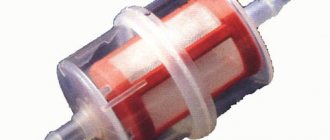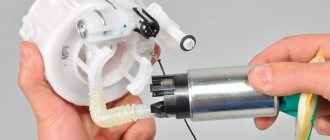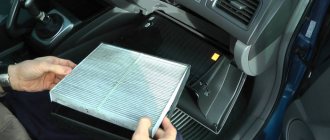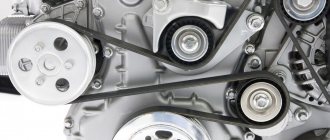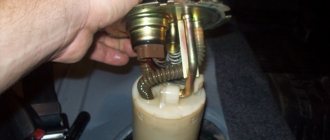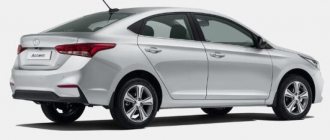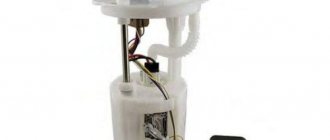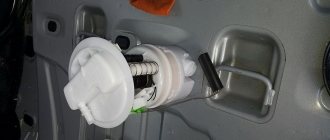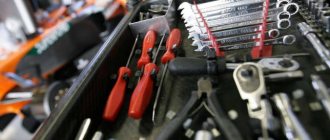Types and design of fuel filters
The design and characteristics of the fuel filter depend on several factors: the type of fuel for which it is intended, engine displacement, type of fuel system, vehicle design and the imagination of the engineer. As a result, quite a few varieties of fuel filters have appeared, which are quite easy to get confused about.
Based on the type of fuel, there are gasoline, diesel and gas filters.
- Gasoline filters are designed for fine purification of impurities in gasoline. They filter out solid particles but do not retain water.
Gasoline filter device - Diesel engines are the most complex in design. In addition to removing dirt, they can filter water from the fuel, accumulating it in a special tank.
Diesel filter device - Gas ones are distinguished by a completely sealed body.
General view of gas filters
Based on their placement, they distinguish between submersible and main filters.
- Submersibles are usually installed on gasoline cars. They are part of a single unit with a fuel pump and a level sensor.
Submersible pump structure with filter: 1 – fine fuel filter housing; 2 – electric fuel pump cover; 3 – fuel filter plug; 4 – electric fuel pump gasket; 5 – rubber stop; 6 – fixing washer; 7 – fuel coarse filter (submersible mesh); 8 – electric fuel pump; 9 — fuel pump module wires.Submersible pump with filter assembly
- Main lines can be installed at any point in the fuel line, from the tank to the injection pump, carburetor or injector.
Device of a remote fuel filter for injection engines
According to the type of gasoline engine.
- For carburetor cars - low-performance, designed for a small volume of fuel.
- For injection engines - with high throughput, greater degree of cleaning.
They also differ in purpose.
- Coarse filter is a simple nylon mesh that is installed at the inlet of the fuel pump and traps only large particles of contaminants, like in submersible filters.
- Fine filters are the same disposable filters that are discussed in most cases.
By design they are divided into direct-flow, screw-on and collapsible.
- The direct-flow type has pipes for connecting to the fuel line. They can be on opposite sides of the body or on one.
- The screw-on filter is very similar in design to an oil filter: it is connected to the fuel line according to the same principle. The inlet and outlet holes are located one inside the other, and this entire structure is screwed onto a special connector.
- Collapsible ones are the most economical. In them, only the filter element is changed, and the housing is reusable.
The typical fuel filter design is the same for gasoline and gas engines.
- Frame. It must be strong enough to withstand operating pressure.
- The pleated filter element through which the fuel passes removes all contaminants.
- Pipes for connecting and discharging excess fuel.
Filters for diesel engines have slightly different requirements for cleaning quality: they must remove water and sulfur impurities from the fuel. Therefore, the filter element is made of a material that differs from the filler of conventional filters. In addition, diesel filters have a separator in which water accumulates. You can clearly see how they work in the video lesson below.
Since diesel fuel always contains paraffins that freeze in winter, many car models are equipped with a filter heater. It is designed to melt paraffin deposits that thicken in the cold and clog the filter.
Fine diesel fuel filter
Small mechanical impurities, which have a size of no more than 60 microns, are also very dangerous for a car engine. They can significantly damage the engine. A fine filter helps clean fuel effectively. It is made of steel as well as very durable plastic and can withstand high system pressure.
The fine filter has 4 sections, which are closed with caps and located in the housing. In the center of the section there is a rod on which an element in the form of a glass is placed. There is filter paper inside it. Thanks to its corrugated surface, it is possible to increase the contact area between the filter and the fuel. The presence of a cardboard frame helps protect the paper from damage. After the fuel enters the filter, thanks to the holes in the frame, it reaches the paper. This element is capable of filtering particles up to 4 microns in size. The passage of diesel fuel from the filter is also carried out through corrugated paper, but it must be changed periodically.
The best place to place the filter is in front of the fuel pump, as there is low pressure here, so leaks can be avoided. In addition, this has a good effect on the operation of the gas pump, since it pumps high-quality purified fuel.
When choosing a filter for fine cleaning, it is better to take a closer look at models with a transparent body. In this case, you can always keep the device under control.
High-quality filtration ensures long-term and uninterrupted engine operation.
Where is the fuel filter located?
Submersible filters are installed inside the gas tank. This module is convenient because you do not need to additionally think of a place to install the filter.
Diagram of the power system with a submersible filter and a remote one: 1 - fuel tank; 2 — submersible coarse filter; 3 - fuel pump; 4 - fuel supply line; 5 — fine fuel filter; 6 — pressure regulator; 7 - fuel rail; 8 - fitting; 9 — nozzles; 10 - fuel drain line.
If the filter is main (remote, fine filter), it can be located either in the engine compartment near the engine, or under the bottom of the car.
Location of the remote fine filter in the engine compartment
FAQ
Where is the fuel filter located?
The exact location of the fuel filter depends on the vehicle's layout. On carbureted cars it is usually located under the hood near the carburetor. In diesel cars, in the engine compartment between the high-pressure fuel pump and the engine. On injection cars it can be located under the bottom, in the engine compartment or in the fuel tank, in the fuel pump module. Exact information about the location of the fuel filter is indicated in the vehicle's operating instructions.
What does a fuel filter look like?
In carburetor cars, it looks like a transparent plastic case with a filter element inside. In modern cars, due to the high pressure in the fuel system, fuel filters are made as more massive metal or thick plastic flasks with filter elements inside. The average filter dimensions are from 10 to 20 centimeters in height, up to 10-12 centimeters in diameter, although deviations are possible. Diesel fuel filters can be more complex in design because they must filter out moisture and wax.
How does a fuel filter work?
The fuel enters the filter housing, passes through the layers of the filter element and leaves the filter clean and further into the fuel system.
When do you change the fuel filter?
The exact time frame for replacing the fuel filter is in the car’s manual or you can find it out at an authorized dealer’s service station in the car’s technical inspection manual. All other recommendations can be considered too average to advise all of them to car owners. The average service life of a fuel filter is at least 40-60 thousand km. Change when symptoms of clogging occur or in accordance with the maintenance regulations.
Related terms
- Gasoline pump
- Fuel pump
- Carburetor
How long does it take to change the fuel filter?
All recommendations for routine filter replacement are given based on European data. This means that the replacement interval was calculated after working with high-quality fuel that was not diluted or contaminated. Also, the service life greatly depends on the type and design of the filter. Each manufacturer also indicates the expiration date of their products.
If we take an average, then built-in (submersible) filters can last 120 thousand km of a car. And if remote (main) - every 20-25 thousand km for different cars.
The fastest and most reliable way to monitor the technical condition of a car, including its fuel system, is a diagnostic scanner. Devices of this kind are quite affordable and pay for themselves in 1-2 trips to the service station. Of those currently on the market, we can recommend Scan Tool Pro Black Edition.
This scanner is compatible with most cars from 1993 onwards. It is enough to have an ODB2 connector and a display device, which can be a phone, tablet or PC. The advantages of this particular model include both engine diagnostics and related vehicle systems.
Replacement Regulations
Signs that you need to replace fuel filters are as follows:
- difficulty stopping the engine,
- spontaneous engine stop,
- reduced power,
- noisy engine operation,
- copious black smoke from the exhaust pipe.
Waiting for the listed symptoms to appear is dangerous. The diesel engine does not tolerate inattention. Delay in replacing fuel filters reduces the life of the engine and provokes premature failure. To avoid trouble, change filters at least as often as recommended by your vehicle's owner's manual.
Already in 1960, the Belgian importer of Volgas began installing several varieties of atmospheric diesel engines on the “twenty-first”, of course, foreign-made. True, the car “stopped driving” at the same time, but in Western Europe already 50 years ago, economy was much more important than dynamics.
Manufacturers are constantly improving fuel filters for diesel engines. The estimated service life of modern replaceable filter elements reaches 90 thousand kilometers. The practical recommendations of car manufacturers are much more modest, which is probably explained by two factors. Firstly, the service life is greatly influenced by low quality fuel. The filters do not have clogging indicators, so it is impossible to check the condition of the filter elements without disassembling them, and it is better to be safe than to cause significant damage to the engine. Secondly, branded service brings significant profits, which brand rights holders are in no hurry to give up.
There are no uniform recommendations for replacing filters for all diesel cars. Typically they range from 25 to 40 thousand kilometers. The cleaner, if present, is coarse, and there is no special recommendation in the car manual; it should be changed along with the main fine cleaning element.
The figures given are only generalized data and are not intended for practical use. Look into the "primer" of your car. It is possible that its manufacturer considers it advisable to change filters more often. For example, for Renault Duster diesel cars in 2015, the filter life was set at 20 thousand km; before this date it was only 10 thousand km.
Low quality fuel significantly reduces filter life. Sometimes one refueling is enough to harm the engine. If you notice something wrong after visiting a gas station, drain the suspicious fuel and fill the tank with a known quality one. Replace the fuel filter as soon as possible, even if the signs of unstable operation have disappeared.
Fuel filter prices
The cost of a filter depends on two parameters: design and brand. And if the car owner cannot do anything with the design of the filter (what the engineers came up with, then he has to buy it), then the choice of brands can “kill” an inexperienced person.
The highest quality and most expensive brands are Delphi (USA), Mahle and Mann (Germany). On average, their price ranges from 20 to 100 USD, but, of course, it all depends on the model and engine size of the car.
Bosch (Germany), as well as Blue Print (Great Britain) and UFI (Italy), rightfully earned the honorary title of people's brand. The most popular types of filters from these brands can be purchased from 10 USD. The upper price level is approximately 80-90 USD.
Budget brands whose product quality is inferior to more expensive analogues, but still not complete trash, are Starline, WIX Filters and Profit. Their price starts from about 5 USD, but everything, of course, depends on the car model and the filter itself. The upper limit, oddly enough, is still the same 80-90 USD.
Which filter is better to choose?
This question is asked to specialists most often, because in most cases the car owner buys the necessary set of spare parts for maintenance himself.
When choosing, first of all you need to find those filters that are suitable for the model and modification of the car. And it is better not to try to modernize the design of the car by installing, for example, a diesel filter in a gasoline engine.
After that, decide on the choice of brand. Everything is simple here: if you want a filter “for yourself” so that you can drive calmly and not count kilometers, choose high-quality brands of the highest category. If you want to carry out the last maintenance before selling, normal budget options are also suitable.
However, most people prefer the best price and quality offers by choosing mid-priced brands. These include, first of all, Bosch, which has long been loved by customers.
Replacing the fuel filter
In principle, there is nothing supernatural about replacing the filter with your own hands. You just need to find a ventilated room, take care of the fire extinguisher and figure out where the filter itself is located.
Watch the video below to clearly see how the filter in the engine compartment is changed using the diesel Hyundai i30 as an example.
To replace a filter installed in the engine compartment or on the fuel line, the procedure is as follows.
- Reduce the fuel pressure so that when you remove the filter, as little fuel spills around as possible. To do this, you need to remove the fuel pump fuse, then start the engine and wait until it stops, draining all the gasoline.
- Remove the negative battery terminal. This is an additional guarantee that a spark will not jump anywhere during operation.
- Disconnect the filter fasteners. It may be secured with a mounting bracket that will have to be removed. And, of course, disconnect the pipes if this is not a screw-on model (they can be secured with latches or bolts). Then remove the filter itself.
- Install a new filter, observing the direction of fluid flow indicated by the arrows. This is important: filter paper is designed for liquid flow in a certain direction.
- Replace the negative terminal and the fuel pump fuse and start the engine. It won't start the first time, that's normal.
If you have to change the submersible fuel filter assembly, it will be a little more complicated. There is also a video below that clearly shows how to change the submersible coarse and fine filters if they are located near the gas tank.
- The first two points remain unchanged: safety first.
- Raise the rear seat and find the fuel module cover underneath. Unscrew it and remove the module.
- The plastic housing contains a fuel pump, a fine filter and a mesh filter. You will have to disassemble the module until you can get to the pleated fine filter. Take it out and put a new one in its place.
- Reassemble the module and check how the engine works.
Safety precautions are especially important in this work: it is important not to inhale gasoline vapors and not to try to smoke out of habit.
Filter location
Now that all readers understand how important and necessary fuel filters for diesel engines are, we can consider the procedure for replacing them. First of all, it is worth carefully studying the location of this node. In this regard, diesel cars are also different. Diesel fuel filters are installed in two different ways. Let's look at each possible option:
- First. The unit is built into the fuel pump and located in the gas tank. To get to it, you will have to gain access to the tank in any possible way. As a rule, it is necessary to remove the rear seat in the car. After this, you can begin repairing the unit. A similar organization of fuel filtration is often used on newer diesel cars (Ford Mondeo 4, Mitsubishi Pajero 4, KIA Soul, etc.).
- Second. The diesel fuel filter is located in a separate unit. In this case, it is also difficult to find the unit - just open the hood, or look under the gas tank and find the characteristic “barrel” behind it - this will be the fuel filter. This type of arrangement of the unit is not uncommon for both old diesel models and new ones (UAZ Patriot, Ford Kuga, etc.).
The location of the diesel fuel filter largely determines how it will be replaced, how difficult this procedure will be and what will have to be done during the process. In any case, repairs of this kind are not complicated, so if necessary, a trip to a service station can be avoided without any problems.
Cleaning the fuel filter
Fuel filters are not cleaned, washed or rinsed, they are simply replaced. Filter paper has a complex structure in which the pore size decreases from the surface into the depth of the material. This means that it acts like a funnel, effectively removing debris while slowly becoming clogged. It is impossible to wash such paper; it can only be replaced.
However, there is a filter that requires similar care: this is a coarse filter installed in front of the fuel submersible pump (submersible). It is simply a fine mesh nylon mesh, so it can be cleaned.
Paper and other filter elements
Paper serves as the main filter element. Despite the general technological process, it is the leader among all filter materials, having great advantages.
Paper is used for a reason; it is folded into a corrugated shape. The material is pressed very strongly, and an accordion with a diameter of 100 mm can accommodate a canvas measuring more than 1 meter.
Interestingly, paper costs account for more than 60 percent of the price of a fuel filter. In fact, you can make the design cheaper, but only at the expense of quality!
Propylene is the material of the future. It has been actively used recently. He has already earned a lot of praise from motorists.
Article on the topic: Insurance procedure in OSAGO transport via the Internet
As for fine-pored metal mesh, it is rarely used as a material for filters.

